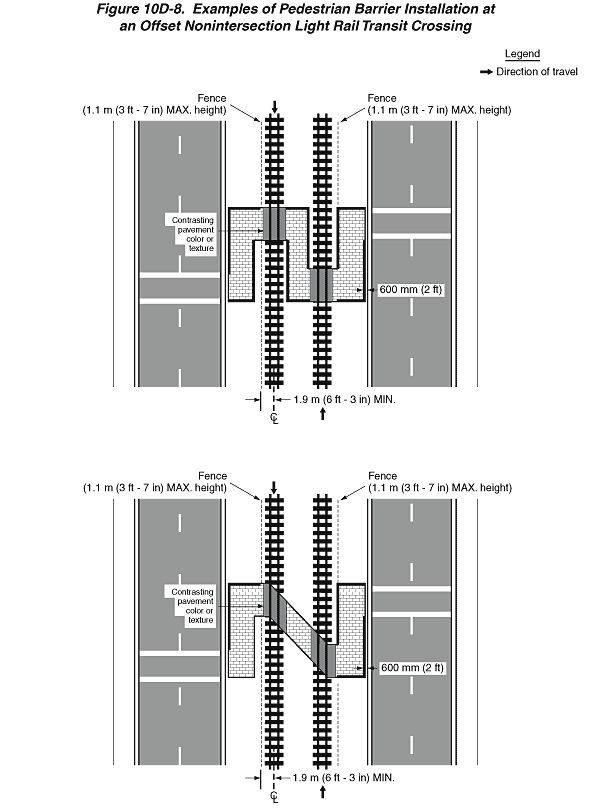|

Figure 10D-8. Examples of Pedestrian Barrier Installation at an
Offset Nonintersection Light Rail Transit Crossing
This figure illustrates two examples of pedestrian barrier installation
at an offset nonintersection light rail transit crossing. A legend
shows a black arrow indicating the direction of travel.
Both examples show two vertical two-lane roadways with two vertical
light rail transit tracks between them. On each roadway, a broken
white line is shown separating the two lanes.
For both examples, black arrows show the direction of travel on
the tracks as from top to bottom on the left track and bottom to
top on the right track. Vertical rectangular areas with small horizontal
rectangles indicating brick walkways are shown on both sides of
the tracks and between them. Two vertical rectangular gray areas
indicating contrasting pavement color or texture are shown crossing
the tracks but are not directly opposite each other; they are offset
by several meters or feet.
For both examples, two vertical broken lines indicating fences
enclose the tracks and are shown extending from the outside edges
of the track crossings and running parallel to the tracks. The fences
are shown as a dimension of 1.1 m (3 ft-7 in) MAX. height. They
are shown as a dimensioned distance of 1.9 m (6 ft-3 in) from a
horizontal broken line indicating the centerline of each track.
For both examples, parallel white lines indicating crosswalks are
shown extending across each vertical roadway lane. The crosswalks
are shown on both sides of the tracks but are not directly opposite
each other; they are offset by several meters or feet.
For both examples, the brick walkways are shown enclosed by broken
black lines indicating sections of pedestrian barriers shown as
a dimensioned distance of 600 mm (2 ft) inside the edge of the brick
walkways. They are shown as set up so that no openings between the
barriers are opposite each other.
In the first example, the brick walkways and track crossings are
shown in a pattern that resembles an upside down "U" connected
to an upright "U." In the second example, the brick walkways
and track crossings are shown in a pattern that resembles an "N."
Back
to Chapter 10D
|

